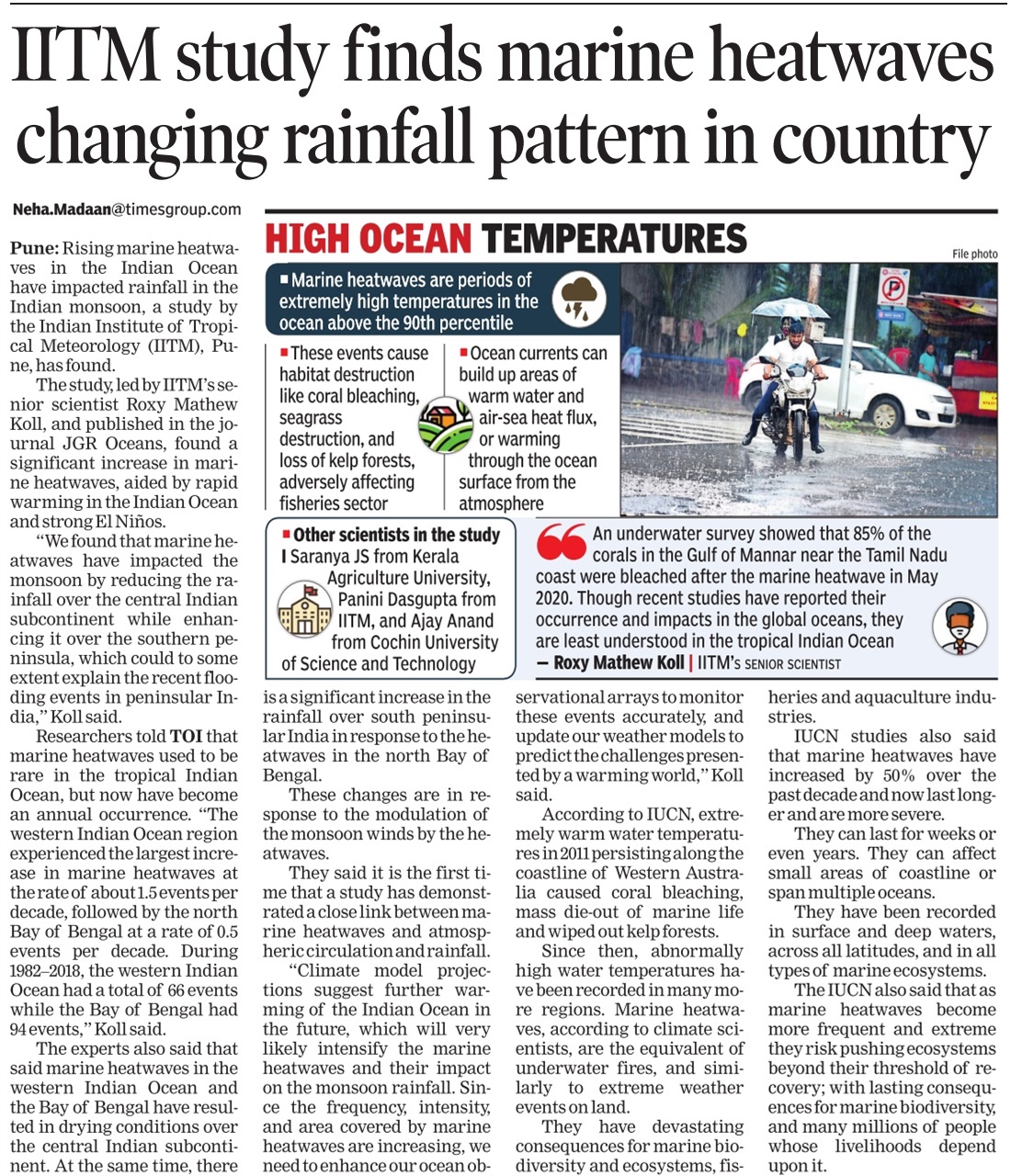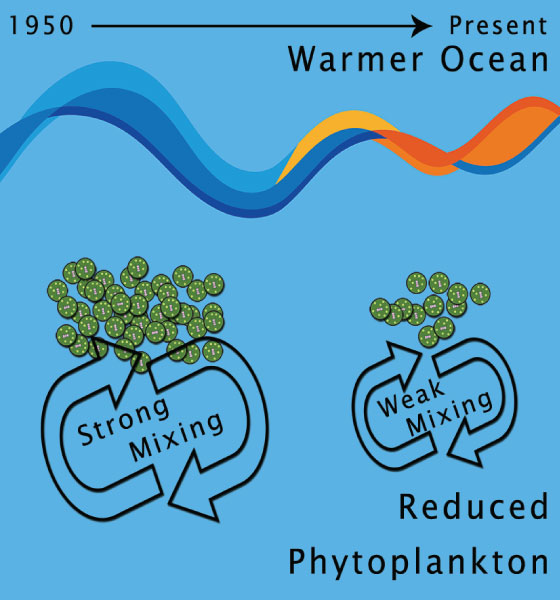 Almost 90% of the extra heat due to increased greenhouse gases has been absorbed by the oceans. Among the tropical oceans, the ocean warming is most prominent in the Indian Ocean, and it is taking a huge toll on the marine ecosystem. A recent study led by Dr. Roxy Mathew Koll, Scientist at the Indian Institute of Tropical Meteorology, and published in the journal Geophysical Research Letters, points out a significant decline in the marine phytoplankton in the Indian Ocean. The authors suggest that the rapid warming in the Indian Ocean is playing an important role in reducing the phytoplankton up to 20% during the past six decades. Such a decline in the marine phytoplankton may cascade through the food chain, potentially turning this biologically productive region into an ecological desert. It may also impact the food security in the Indian Ocean rim countries and also the global fisheries market.
Almost 90% of the extra heat due to increased greenhouse gases has been absorbed by the oceans. Among the tropical oceans, the ocean warming is most prominent in the Indian Ocean, and it is taking a huge toll on the marine ecosystem. A recent study led by Dr. Roxy Mathew Koll, Scientist at the Indian Institute of Tropical Meteorology, and published in the journal Geophysical Research Letters, points out a significant decline in the marine phytoplankton in the Indian Ocean. The authors suggest that the rapid warming in the Indian Ocean is playing an important role in reducing the phytoplankton up to 20% during the past six decades. Such a decline in the marine phytoplankton may cascade through the food chain, potentially turning this biologically productive region into an ecological desert. It may also impact the food security in the Indian Ocean rim countries and also the global fisheries market.
Marine Phytoplankton
Almost all life on earth is directly or indirectly dependent on primary production–where by organic compounds are produced through photosynthesis. Marine phytoplankton, which constitutes half of the global net primary production, are the microscopic plants in the ocean. These phytoplankton sustains the aquatic food web, drives the marine ecosystem, and constrains the global fisheries catch. In addition, the phytoplankton absorbs the solar radiation and modulates the upper ocean heat flux, thereby influencing climate processes and biogeochemical cycles, particularly the carbon cycle.
Marine Phytoplankton in the Indian Ocean
Over the tropical oceans, the Indian Ocean (especially the western region) hosts one of the largest concentration of phytoplankton blooms in summer. This is because of the strong monsoonal wind forcing which leads to ocean upwelling, supplying nutrients from the subsurface to the surface, and supporting elevated rates of primary productivity.

Large-scale distribution of tuna and other fishes are associated with the phytoplankton availability and abundance. FAO statistics show that the Indian Ocean accounts for 20% of the total tuna catch, especially the most economically valuable bigeye tuna, making it the 2nd largest supplier to world markets.
Rapid warming in the Indian Ocean
Interestingly, the region in the Indian Ocean with the largest phytoplankton concentrations is also the region which exhibits the largest ocean surface warming. The warming during the past century is up to 1.2°C, which is very large compared to a global surface warming of up to 0.8°C during the same period.

However, due to the lack of long-term data, earlier studies were unable to extract the impact of the rapidly warming Indian Ocean.
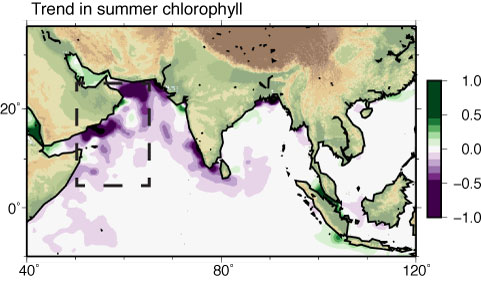 Decline in the marine productivity due to rapid warming in the Indian Ocean
Decline in the marine productivity due to rapid warming in the Indian Ocean
Our research extends the study period using data from multiple satellite sensors, and also historical simulations from climate models. The historical simulations indicate that the marine phytoplankton has decreased up to 20% during the past six decades. Meanwhile the recent satellite data show that the decline is up to 30% in the western Indian Ocean during last 16 years.
How does the ocean warming suppress the marine productivity?
Rising ocean surface temperatures results in less dense water on the surface and denser water in the subsurface, which is known as stratification. Such a stratified condition inhibits the vertical mixing of subsurface waters (which are usually nutrient rich) to the surface. The vertical mixing is a critical process for introducing nutrients into the upper zones where sufficient light is available for photosynthesis.
Future
Climate models suggest that Indian Ocean will continue to warm under increasing greenhouse gases. Our study indicates a further decline in phytoplankton in the Indian Ocean, suggesting the vulnerability of the marine ecosystem.
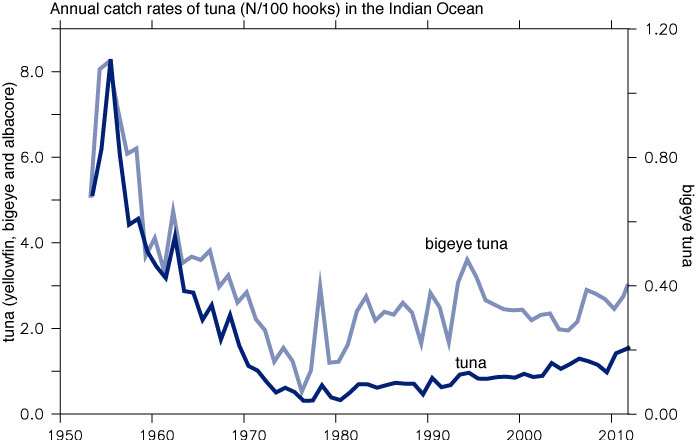 Fisheries/Impact
Fisheries/Impact
Available data show that the tuna catch rates in the Indian Ocean have declined by 50-90% during the past five decades. Increased industrial fisheries is a major cause for such a huge decline. However, the reduced phytoplankton may add up as a potential stress factor–and exploiting a resource that may be in decline can tip it over to a point of no return. Decline in the fisheries in this area can affect the developing countries in the rim (South Asia, Africa), and also make it difficult to meet the demand from the global fisheries market, especially from countries like Japan, USA and several EU countries.
Team behind the study
Roxy Mathew Koll, Aditi Modi, Vinu Valsala, Swapna Panickal (IITM, Pune), Prasanna Kumar (NIO, Goa), M. Ravichandran (INCOIS, Hyderabad), Raghu Murtugudde (University of Maryland, USA), Marcello Vichi (University of Cape Town, South Africa) and Marina Lévy (Sorbonne Université, France).
Media Highlights: The study received huge attention in the media, with many newspapers covering it as front page headlines. See our media section for details.
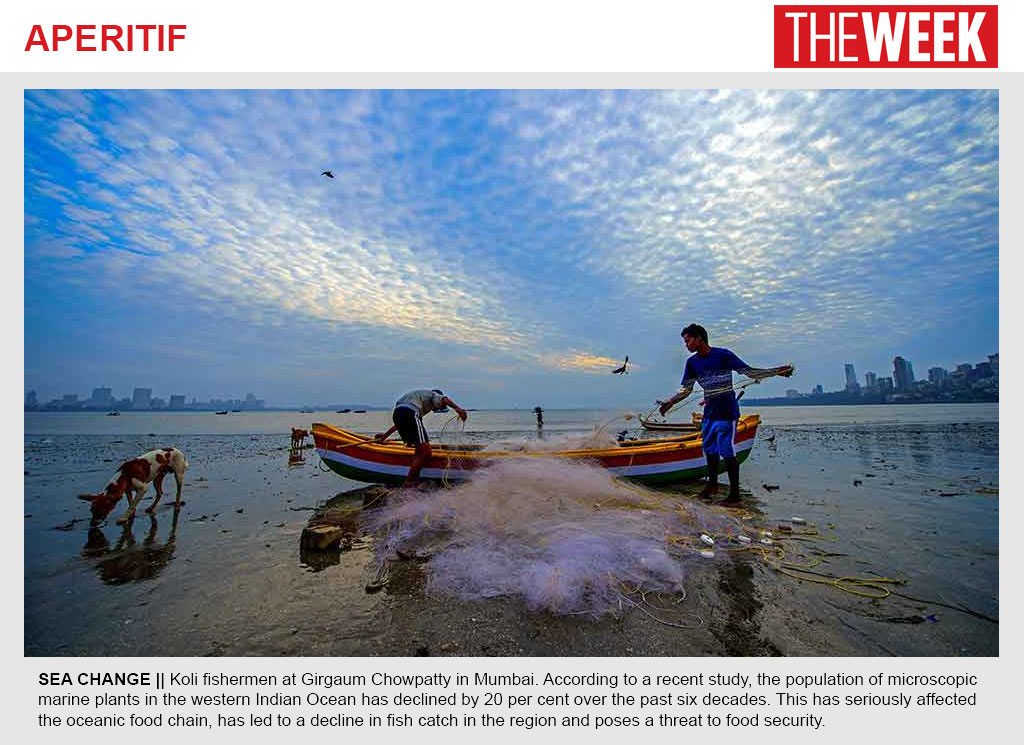
Reference:
Roxy M. K., A. Modi, R. Murutugudde, V. Valsala, S. Panickal, S. Prasanna Kumar, M. Ravichandran, M. Vichi and M. Levy, 2015: A reduction in marine primary productivity driven by rapid warming over the tropical Indian Ocean.Geophys. Res. Lett., 42, doi:10.1002/2015gl066979 [pdf] [supplement]



